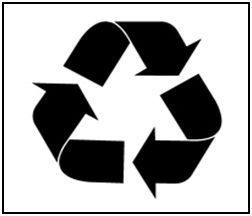 What does the recycling symbol represent?
What does the recycling symbol represent?
Hint: “reduce, reuse, recycle” is an incorrect answer!
We’ll provide the answer in a minute, but in the meantime, here are some more recycling myths.
Did you know…
- Commingled and single stream recycling mean the same thing.
Watch this video that explains the high tech separation process employed by material recovery facilities.  Plastic bags should be taken to retail establishments for recycling.
Plastic bags should be taken to retail establishments for recycling.
That includes your bread bag, dry cleaning bag, and grocery bags.- The cap of a plastic bottle is just as recyclable as the bottle
- Rechargeable batteries contain more chemicals than the traditional alkaline batteries.
But, they are considered better for the environment because they last longer and are recyclable.
3 Recycling Myths Explained
Answer: False
 The code on a plastic product does not mean that material is necessarily recyclable in your community or has been recycled. It just identifies the type of plastic resin.
The code on a plastic product does not mean that material is necessarily recyclable in your community or has been recycled. It just identifies the type of plastic resin. Answer: False
Answer: True
Take Action, and Recycle!
If your school wants to step up your recycling, get some ideas from the PLT GreenSchools Waste and Recycling Investigation. If you want a challenge, consider competing in a race with other schools to collect the most recyclables. The Recycle-Bowl is a free competition and benchmarking tool for K-12 school recycling programs that promotes waste reduction activities.
Oh, and here’s that answer to “What does the recycling symbol represent?”
Answer: 1. Collect recyclables. 2. Process them into a new product. 3. Buy products with recycled content.


